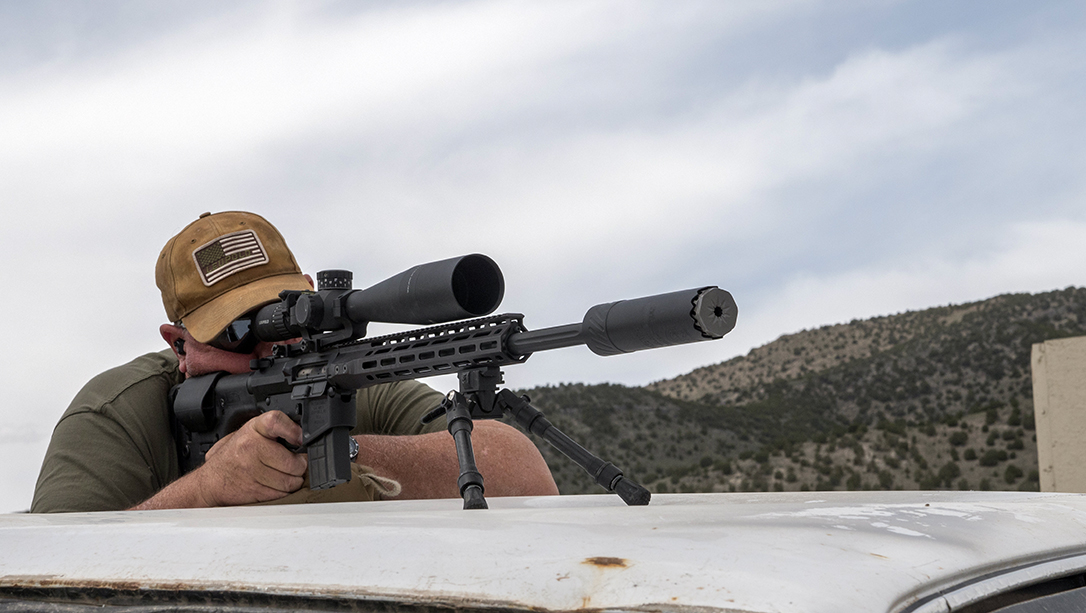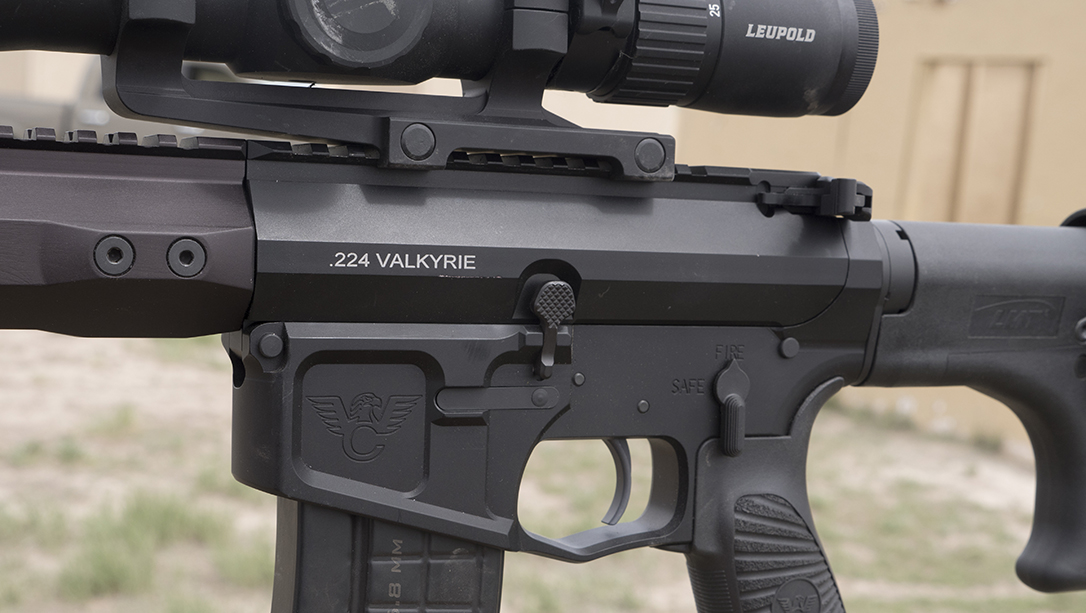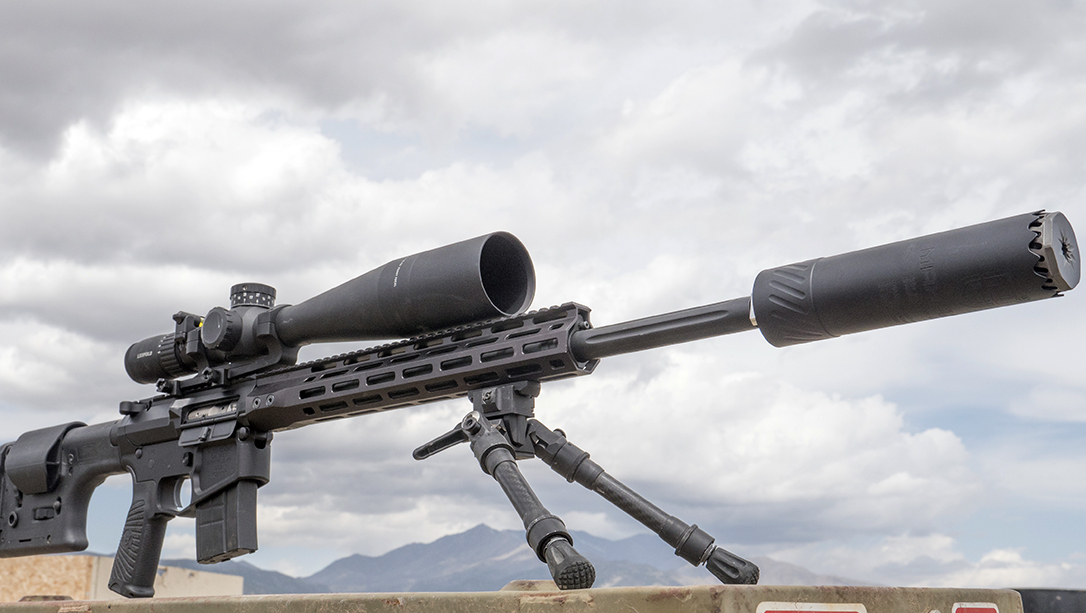Federal Premium’s introduction and subsequent support of the new .224 Valkyrie has resulted in quite a bit of interest. As far as new cartridges go, it grew legs rather quickly, and several mainstream manufacturers are now building rifles specifically chambered for this new caliber. Among them is the Wilson Combat Super Sniper.
Federal currently offers four different .224 Valkyrie loads for range practice, hunting and competition. Hornady just introduced an 88-grain load using its ELD Match bullet. DoubleTap Ammunition’s Mike McNett also told me that he is working on a load. Other companies are just waiting to see if the .224 Valkyrie will remain popular, but so far its future looks bright.
Advertisement — Continue Reading Below
But what makes the .224 Valkyrie stand out? According to Federal, it “provides less wind drift and drop than all other loads in its class and stays supersonic past 1,300 yards.” And this is from an AR-15-sized rifle, mind you, not a larger AR-10-style offering. As long-range competitions like the Precision Rifle Series (PRS) have grown in popularity, so has the desire for a lightweight semi-auto, and this is where the new caliber comes in. Some have compared it to the .22-250, but I say it’s closer to the 6.5 Creedmoor. But to test this new chambering, first I needed a gun to go with it.
Wilson Combat Super Sniper Specs
When I was given the task of testing a bunch of semi-automatic rifles for sister publication Ballistic’s Best, I naturally reached out to Wilson Combat, which submitted a new Super Sniper rifle—and the only AR in .224 Valkyrie. It performed well and, out of 17 contestants, ended up finishing third overall. Its accuracy was among the best tested, and every evaluator liked it.
Wilson’s Super Sniper starts with upper and lower receivers crafted from a billet of 7075-T6 aluminum. The fluted, 20-inch, stainless steel barrel has a heavy contour and a 1-in-7-inch twist rate. The muzzle has 1/2×28-tpi threading to accept suppressors and other muzzle devices.
Advertisement — Continue Reading Below
A rifle-length gas system and an adjustable gas block pair with the barrel. Wilson also installs its newest 13.8-inch TRIM handguard with M-LOK slots along the sides and bottom to complement the full-length Picatinny top rail. The upper features a premium NP3-coated bolt carrier utilizing a 6.8 SPC bolt. This means the gun runs with 6.8 SPC magazines, and one 15-round Precision Reflex Inc. (PRI) magazine was provided for testing.
Both the upper and lower receivers are hardcoat anodized and then given Wilson Combat’s renowned Armor-Tuff finish. The lower also sports Wilson/Rogers Super-Stoc, a Starburst pistol grip and the company’s own two-stage Tactical Trigger Unit (TTU). All together, the rifle comes in a nice soft-sided case.
Wilson Combat Super Sniper: Two-Gun Test
Using an AR-15-sized gun instead of a larger AR-10 helps save weight and potentially recoil. This means you can more easily see if your first shot is a hit or a miss, which is huge in the long-range game. That’s why a lot of PRS competition guns use muzzle brakes. Sure, they can be loud and punishing, but they control muzzle rise and recoil. A smaller caliber that gets the job done sounds promising as long as it’ll perform at range. Of course, dedicated gas gun matches are typically limited to 800 yards, so I set the Wilson Combat Super Sniper up for that purpose.
Advertisement — Continue Reading Below
I installed a Leupold 5-25x56mm Mark 5 HD scope with a Horus T3 reticle. This optic offers tactile and easy-to-read adjustments, crystal-clear glass and all the magnification you might need without the weight. I also replaced the Super-Stoc with a Lewis Machine & Tool (LMT) DMR556 stock, which provides more stability for long shots. Then I added a Modular Evolution bipod as well as NG2 Defense’s new MAXFLO 3D suppressor, which keeps the barrel steady without any excessive backpressure.
But I didn’t want this to be a standard range evaluation. I wanted to see how the gun fared against a 6.5 Creedmoor rifle, so I enlisted a Wilson Tactical Hunter in that chambering and outfitted it with the same LMT stock and MAXFLO 3D suppressor. Its barrel was also 20 inches long, though it had a lighter contour. For a scope, I used a 7-35x56mm Nightforce ATACR with a Horus T3 reticle to keep my holds and adjustments identical. I also installed an Atlas bipod.
Shooting the Wilson Combat Super Sniper
Federal made this comparison pretty easy with Gold Medal Match loads in both calibers: 90-grain SMKs for the .224 Valkyrie and 130-grain Gold Medal Bergers for the 6.5 Creedmoor. I fired some groups with both rifles at 100 and 300 yards before engaging a 12-inch steel target at 855 yards. The Horus T3 reticle worked well for most of the testing, and I didn’t have to adjust any scope knobs until it was time to make shots at 1,000 and 1,300 yards. The reticle utilizes mils for elevation holds, while “wind dots” mark the wind adjustments.
Advertisement — Continue Reading Below
My five-shot groups at 100 yards were comparable. I’ve tested several Wilson Combat ARs, and they’ve all shown sub-MOA accuracy. Here the .224 Valkyrie produced groups measuring less than half an inch at 100 yards using the 90-grain SMKs—not once, but at least four different times. The 6.5 Creedmoor’s accuracy was similar, with groups in the 0.5- to 0.6-inch range. At 300 yards, the results were relatively the same, with the .224 Valkyrie producing groups just over an inch wide while the 6.5 Creedmoor’s were just under 1.5 inches.
Ringing Steel
The real test was on steel at range, and the Valkyrie acquitted itself nicely. At 400 yards and using a 2-mil hold, I was able to cluster three rounds in the center of my target just above the 1.8-mil hold. The hold required for the 6.5 Creedmoor was roughly the same, and my groups between both rifles stayed within a half-mil of each other out to 855 yards, where I have another steel target placed. In other words, out to 855 yards, the difference in holds for both elevation and wind were mostly negligible.
The results started to separate at 1,000 and 1,300 yards. At 1,000 yards, the .224 Valkyrie required an 8.6-mil hold to hit the 16-by-22-inch target, and the 6.5 Creedmoor required 7.5. It wasn’t harder to get hits with the former—just seeing and hearing the impacts. At 1,300 yards, the .224 Valkyrie needed 13.8 mils while the 6.5 Creedmoor needed 12.4 mils, and the former also required an additional wind dot. According to my Kestrel, at that distance, the .224 Valkyrie’s velocity was still at 1,200 fps (compared to the 6.5 Creedmoor’s 1,300 fps) which surprised me. But its energy on target was 298 foot-pounds—quite a bit less than the 6.5 Creedmoor’s 498 foot-pounds. So, like I said, hitting steel that far away wasn’t an issue, but knowing you did was a bit more problematic.
Advertisement — Continue Reading Below
The .224 Valkyrie Verdict
First and foremost, the Wilson Combat Super Sniper in .224 Valkyrie is accurate, consistent and reliable. Using either a muzzle brake or the NG2 MAXFLO 3D suppressor, the recoil wasn’t much different than a rimfire’s. It was easy to watch hits from a distance, too, even from some less stable positions. And like I said, the fit and finish were excellent. I would only switch to an ambidextrous safety and charging handle for this kind of shooting, but the Super Sniper’s trigger is perfect.
If your targets are paper or steel, a 20-inch-barreled .224 Valkyrie is just as capable at 800 yards with less recoil, barrel movement and weight. For gas gun matches in moderate wind with 800-yard limits, this kind of gun will be my first choice, replacing my trusted .260 Remington. The weight savings and lack of barrel movement are worth it alone. If I wanted to use a gas gun in a match reaching beyond 1,500 yards, I’d probably go with the 6.5 Creedmoor because its higher ballistic coefficient makes a huge difference at long range or in really stiff winds.
Hunting applications are a bit more complicated and will need its own article. Suffice it to say that the .224 Valkyrie’s velocities are impressive. Its use in a DMR setup is another question I will answer shortly after taking a .224 Valkyrie to the next Follow Through Consulting Scoped Carbine class. There is no better place to test such a rifle.
Advertisement — Continue Reading Below
Final Thoughts
In the end, this caliber seems to be holding interest with more companies jumping on board every few months. Ammunition is available and well supported, and you can get everything from a mid-priced rifle to full-custom builds. If you are already a 6.8 SPC fan, this is an easy swap—you just need a new barrel. Time will tell if the momentum continues, but the .224 Valkyrie clearly performs well and will become my first choice for PRS-style gas-gun matches, and Wilson Combat is a great place to start.
For more information, visit wilsoncombat.com.
Wilson Combat Super Sniper Specifications
- Caliber: .224 Valkyrie
- Barrel: 20 inches
- OA Length: 38 inches
- Weight: 7 pounds (empty)
- Stock: Wilson/Rogers Super-Stoc
- Sights: None
- Action: Direct impingement semi-auto
- Finish: Armor-Tuff
- Capacity: 15+1
- MSRP: N/A
Performance: WILSON COMBAT SUPER SNIPER
Federal 60-grain Ballistic Tip:
Advertisement — Continue Reading Below
- Velocity: 3,270 fps
- Accuracy: 0.70 inches
Federal 90-grain Fusion SP:
- Velocity: 2,708 fps
- Accuracy: 0.68 inches
Federal 90-grain SMK:
- Velocity: 2.715 fps
- Accuracy: 0.55 inches
Bullet weight measured in grains, velocity in fps by chronograph and accuracy in inches for best five-shot groups at 100 yards.
Advertisement — Continue Reading Below


























